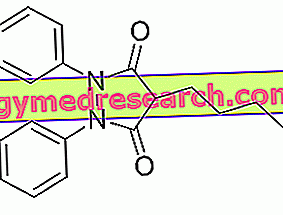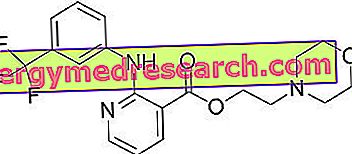Phenylbutazone is a non-steroidal anti-inflammatory drug (or NSAID), with marked analgesic and anti-inflammatory properties.
From the chemical point of view, phenylbutazone is a pyrazolonic derivative.

Phenylbutazone - Chemical Structure
Due to the side effects that it can cause, currently, phenylbutazone is used only externally for topical use. In fact, it is available as a cream.
Examples of medicinal products containing Phenylbutazone
- Kadol ®.
Indications
For what it uses
The use of phenylbutazone is indicated for the local treatment of different types of disorders, including:
- Stretching and muscle pain;
- Joint pains;
- Bruises;
- Distortions;
- Hematoma;
- Solar rashes;
- Light burns;
- Geloni;
- Insect bites;
- Itch.
Warnings
Phenylbutazone for topical use must be applied only and exclusively to intact skin.
If there is inflammation of the superficial veins or in the case of varicose veins, the drug should be applied very gently.
The use, especially prolonged, of drugs for topical use can lead to the onset of sensitization phenomena. If this occurs, treatment with phenylbutazone should be stopped immediately and a doctor should be consulted immediately.
Interactions
Phenylbutazone may interfere with the activity of the following drugs:
- Other NSAIDs ;
- Oral hypoglycemic drugs;
- Sulfonamides (antibacterial drugs);
- Oral anticoagulants, such as warfarin;
- Anticonvulsants, such as phenytoin.
If you are already taking any of the following medicines, you should tell your doctor, as adjustments may be needed in the doses administered.
In any case, it is still advisable to inform your doctor if you are taking - or if you have recently been - medicines of any kind, including medicines without a prescription and herbal and homeopathic products.
Side effects
Currently, no side effects have been reported following the external administration of phenylbutazone at the recommended dosages.
However, phenylbutazone for topical use - especially if used for long periods of time - can give rise to sensitization phenomena that can occur with symptoms such as:
- Persistent redness of the skin;
- Swelling of the skin;
- Swelling of the mucous membranes;
- Itch.
These effects are usually temporary, but if they do appear, you must immediately stop the treatment with the drug and inform your doctor immediately.
Action mechanism
Phenylbutazone is a non-steroidal anti-inflammatory drug and - as such - performs its pain-relieving and anti-inflammatory action by inhibiting cyclooxygenase (or COX).
Cyclooxygenase is an enzyme of which three different isoforms are known: COX-1, COX-2 and COX-3. COX-1 is a constitutive isoform involved in the mechanisms of cellular homeostasis. COX-2, on the other hand, is an inducible isoform that is produced by inflammatory cells (inflammatory cytokines) activated. The task of these enzymes is to convert the arachidonic acid present in our body into prostaglandins, prostacyclines and thromboxanes.
Prostaglandins - and especially prostaglandins G2 and H2 (respectively PGG2 and PGH2) - are involved in inflammatory processes and mediate pain responses.
Phenylbutazone, therefore, is able to inhibit COX-2, thus preventing the formation of prostaglandins responsible for pain and inflammation.
Mode of Use - Posology
As mentioned, phenylbutazone is available for topical administration in the form of a cream.
Generally, it is recommended to apply the cream two or three times a day directly on the inflamed and aching part and to massage until the product is completely absorbed.
To avoid the occurrence of possible side effects, it is essential to follow carefully the instructions given by the doctor, both as regards the amount of drug to be used, both as regards the frequency of administration and the duration of the therapy itself.
Pregnancy and breastfeeding
The use of phenylbutazone in pregnant women and breast-feeding mothers should only be done if the doctor considers it absolutely necessary and only if the expected benefits for the mother outweigh the potential risks to the fetus or baby.
However, pregnant women and breastfeeding mothers should always seek medical advice before taking any type of medication.
Contraindications
The use of phenylbutazone is contraindicated in the following cases:
- In patients with hypersensitivity known to the same phenylbutazone;
- In patients with known hypersensitivity to other pyrazolonic derivatives (such as oxyphenbutazone, antipyrine, aminopirin or dipyrone);
- In patients with a predisposition to the onset of skin lesions, varicose ulcers and / or eczema.



